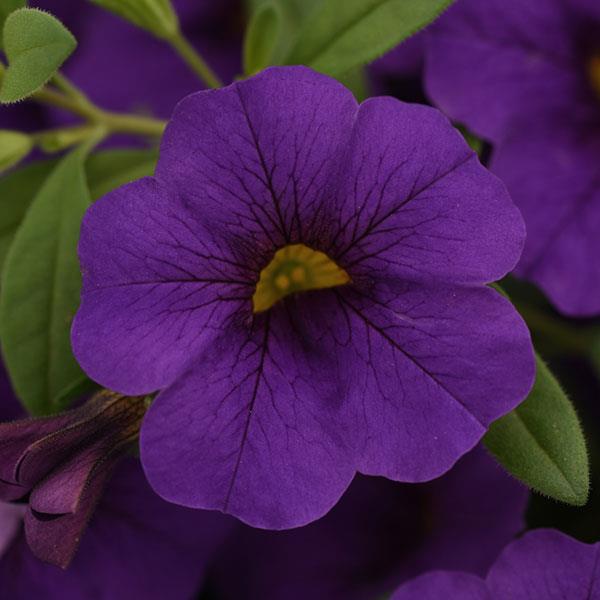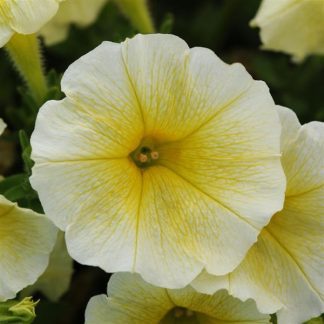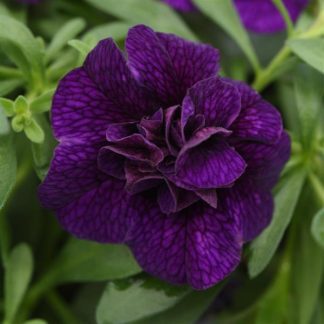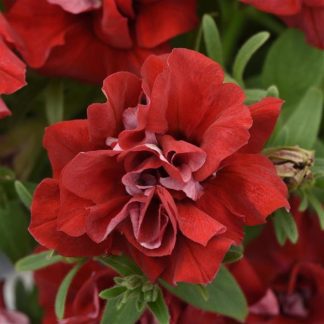Description
Cabaret Blue Calibrachoa: A Friendly Guide to Waves of Sky-Blue Cheer
Introduction
Have you ever watched the morning sky melt into soft blue as the sun rises? Cabaret Blue Calibrachoa captures that sweet moment. We love how each bloom looks like a tiny petunia dipped in sapphire paint. You plant one basket, and suddenly the porch shines. In other words, this plant is color you can hold in your hands. But most of all, it is easy. In the pages ahead we’ll explore every part of its story, from its simple beauty to the care steps that keep it glowing all season. Let’s walk through the blue together.
Meet Cabaret Blue
Cabaret Blue sits in the Cabaret series, a family of calibrachoa bred for nonstop flowers. The series comes from careful work by plant scientists who wanted bold color, strong habits, and garden-friendly toughness. Cabaret Blue stands out because its petals show a true cobalt tone. The center carries a faint yellow ring that glows like sunshine in deep water. Plants grow in rounded mounds only six to ten inches tall, yet they spill up to twenty inches wide. That shape makes them perfect for hanging baskets, tall urns, and window boxes where trailing stems can shine.
A Color Story
Why does this shade feel so special? Many “blue” flowers drift toward purple. Cabaret Blue leans the other way. It reads as blue even at dusk. After more than a decade of trials, growers confirm that the tone stays stable even in heat. You will see hundreds of blooms at once because each stem branches freely. When older blooms fade, young buds rush forward, so the curtain of color never closes. This constant show turns a simple deck into a seaside escape. Friends will swear you have a secret lighting trick.
Habit and Growth Pattern
Instead of stretching upward like tall petunias, Cabaret Blue creates dense, trailing ropes of bloom. Tiny leaves, soft and glossy, form a neat backdrop. The plant finishes fast—about ten to twelve weeks from plug to finished pot—so you can start enjoying color sooner. Roots are fibrous and shallow, which means they like loose media with good air pockets. One plant fills an eight-inch hanging pot with ease, while three plants flood a fourteen-inch basket, leaving no gaps.
Blooming Calendar
Calibrachoa offer one of the longest bloom windows in the annual world. Cabaret Blue starts in early spring once nights sit above 55 °F and keeps going until the first hard frost. Deadheading is optional because spent blooms shed on their own. Instead of fussing with scissors, you can simply admire.
Landscape and Container Uses
Cabaret Blue shines wherever you give it some height to drape. Picture a hanging basket swaying beside your doorway, the blue bells nodding in the breeze. Partner it with white bacopa or golden sweet potato vine for classic contrast. In mixed patio pots, place Cabaret Blue near the rim so it cascades over the edge. In raised beds, tuck it into crevices between rocks. Even a single plant in a clay pot on the steps can brighten the entry. The color mixes well with cool silver foliage or fiery orange calibrachoa cousins.
Pollinator Playground
Bees adore calibrachoa. The tube-shaped blooms hold nectar deep inside, rewarding short-tongued bees, hoverflies, and the occasional hummingbird. Butterflies often land for a quick sip, wings vibrating like jewels. By planting Cabaret Blue, you’re setting a table for helpful friends. In other words, your blue basket becomes part of the local ecosystem. Children love spotting visitors, so this plant doubles as an easy science lesson right outside the back door.
How to Care for Cabaret Blue Calibrachoa
Light and Location
Sun drives flower power. Provide at least six hours of direct sun each day. Morning sun with light afternoon shade works in very hot zones, but full sun gives the boldest color. Indoors or in shade the plant stretches, blooms thin out, and foliage pales.
Soil and Potting Mix
Roots need air. Choose a high-quality, peat-based mix blended with perlite or bark. Aim for a pH between 5.5 and 6.2. Cabaret Blue absorbs iron best in slightly acidic soil; if pH creeps higher, leaves may yellow. In garden beds, amend with compost and coarse sand to loosen clay. Raised planters work wonders because drainage stays sharp.
Watering Wisdom
Cabaret Blue likes steady moisture but hates wet feet. Stick a finger one inch into the mix. If it feels dry, water deeply until liquid runs from the pot base, then empty saucers. During heat waves baskets may need daily drinks. Instead of overhead spray, water at the base to keep blooms fresh. After more than one soggy day, step back and let the soil breathe.
Feeding for Endless Blooms
Heavy flowering takes energy. Mix a slow-release fertilizer into the potting soil at planting time. Then, every ten to fourteen days, drench with a water-soluble fertilizer rich in nitrogen and iron. Many gardeners favor a 20-10-20 formula. If leaves pale or bloom count dips, add a chelated iron supplement. In other words, feed the plant and it will feed your eyes.
Pruning and Grooming
You rarely need to prune, but a light trim in midsummer can refresh shape. Snip back long runners by one-third. New shoots pop from hidden nodes, giving thicker coverage. Remove any yellow or damaged leaves to maintain airflow. Pinch the very tips of stretched stems to encourage branching. The whole process takes five minutes and pays in fuller, tidier plants.
Temperature and Season Extension
Cabaret Blue loves mild warmth. Ideal air temps hover between 60 and 80 °F. It handles brief spikes to 95 °F with extra water. At 40 °F growth slows but the plant survives. Frost, however, ends the show. If you want blooms into autumn, move containers indoors on cold nights or cover them with frost cloth. In zone 9b and warmer, overwinter cuttings or root pieces in a sheltered spot, then replant in spring.
Pest and Disease Notes
Healthy plants face few troubles. Watch for aphids and whiteflies; they gather on tender tips. Blast them away with water or treat with insecticidal soap. Fungus gnats appear in overly wet media. Let soil surface dry between drinks and add a thin layer of coarse sand. Root rot is the main danger. It creeps in when drainage is poor, so choose the right mix and containers with holes.
Companion Combinations
Enjoy pairing Cabaret Blue with plants that contrast in color or leaf shape. Try sunny yellow bidens, lime-green coleus, or ivy geraniums with pink splash. Verbena in frosty white echoes the yellow throat, making the blue pop. Instead of defaulting to petunias, reach for trailing dichondra or silver falls for a soft waterfall effect.
Propagation Pointers
Calibrachoa propagate best from cuttings, not seed. To create backups, snip non-flowering shoots four inches long in late summer. Strip lower leaves, dip cut ends in rooting powder, and stick them into moist, sterile mix. Keep humidity high. Roots appear within two weeks. After more than four weeks, transfer to small pots and feed lightly. This approach lets you save favorite colors year to year.
Eco-Friendly Tips
We can garden with care for our planet. Use organic fertilizers when possible. Recycle plastic pots or switch to compostable fiber baskets. Collect rainwater in barrels and use it for daily watering; Calibrachoa enjoy the slightly acidic nature of rain. Mulch surrounding soil in beds with shredded leaves to conserve moisture and reduce weeds.
Kid-Friendly Activities
Invite children to paint plain pots in blue and white patterns, then plant Cabaret Blue together. Track pollinator visits in a simple journal, tallying bees and butterflies. In other words, turn a flower into a lesson in art, math, and nature all at once. Short tasks, bright results.
Seasonal Displays
Spring: Pair with pastel pansies for gentle contrast.
Summer: Mix with fiery lantana and purple fountain grass for tropical spark.
Autumn: Combine with ornamental kale and small pumpkins in porch pots.
Holiday: Weave battery lights through trailing stems for a glowing wreath.
Frequently Asked Questions
- Does it need deadheading?
No. Spent blooms fall away on their own. - Can I grow it from seed?
Cabaret Blue is usually vegetative only. Cuttings keep color true. - What causes yellow leaves?
Often high pH or waterlogged soil. Check pH, reduce watering, feed iron. - Is it safe for pets?
Calibrachoa are not known to be toxic, but always discourage munching. - How many plants per basket?
One plant fills an eight-inch pot. Three plants fill a fourteen-inch pot. - How long will it bloom?
From early spring until frost with good care.
Design Inspiration Gallery
- Nautical Theme: Blue flowers with white bacopa in a navy pot give coastal vibes.
- Pollinator Party: Mix blue with orange zinnia and red salvia for hummingbird heat.
- Cool Shade: Blue, silver dusty miller, and variegated ivy create a moonlight mix.
- Cottage Charm: Partner with pink verbena and lavender alyssum for soft romance.
Step-by-Step Planting Guide
- Gather materials: quality potting mix, slow-release fertilizer, pot with drainage.
- Moisten the mix until it clumps lightly.
- Fill pot two-thirds full.
- Ease plant from cell pack, teasing roots gently.
- Set plant so crown sits level with soil surface.
- Fill around roots, firming lightly.
- Water until excess drains.
- Place in full sun spot.
- Feed every two weeks with soluble fertilizer.
- Enjoy the color parade all season.
Garden Journal Prompt
Record first bloom date, peak show, and visitor notes. Over time you’ll learn local rhythms. Instead of guessing, you’ll plan better plant partners and replant dates.
Beyond the Basket
Think outside containers. Spill Cabaret Blue along retaining wall tops where stems can cascade. Plant on the sunny side of raised vegetable beds to lure pollinators. Let it fill gaps at the edge of perennial borders while young perennials bulk up. The blue acts like a cool breath among warm tones.
Sustainability Snapshot
Cabaret Blue supports pollinator health without heavy chemical input. Its long bloom window means fewer seasonal replantings, thus less resource use. Keeping pots well-watered with captured rain, choosing organic feeds, and composting spent plants closes the loop.
Troubleshooting Quick-Reference
Problem – Likely Cause – Quick Fix
Yellow leaves – High pH – Add iron chelate, lower pH.
Wilting in moist soil – Root rot – Improve drainage, reduce water.
Sparse blooms – Low light or nutrients – Move to sun, fertilize.
Sticky residue – Aphids – Spray with insecticidal soap.
Brown edges – Drought stress – Water deeply, add mulch.
A Simple Summary
Cabaret Blue Calibrachoa is more than a plant. It’s a tide of blue joy that rolls through the garden from spring until frost. We give it sun, airy soil, steady water, and regular feed. In return it showers us with color, pollinator visits, and endless design options.
Blue Horizons Await
Let’s plant, watch, and share the sky in a basket. Together we can fill our spaces with calm blue light and gentle buzzing life. Happy growing!




